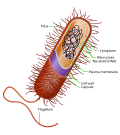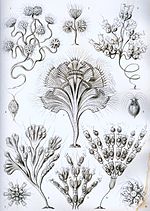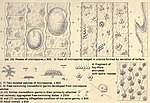include the earlier two-empire system (with the empires Prokaryota and Eukaryota), and the eocyte hypothesis (with two domains of Bacteria and Archaea...
12 KB (1,293 words) - 00:44, 25 July 2024
Excavata is an extensive and diverse but paraphyletic group of unicellular Eukaryota. The group was first suggested by Simpson and Patterson in 1999 and the...
20 KB (1,637 words) - 04:44, 22 April 2024
Archaebacteria). Organisms with nuclei are placed in a third domain, Eukaryota. Prokaryotes evolved before eukaryotes, and lack nuclei, mitochondria...
44 KB (4,770 words) - 11:49, 31 July 2024
Kingdom (biology) (redirect from Kingdoms of the Eukaryota)
later be expanded to the three-domain system of Archaea, Bacteria, and Eukaryota. The differences between fungi and other organisms regarded as plants...
74 KB (4,819 words) - 10:13, 22 July 2024
classification of Anas platyrhynchos (the mallard duck) with 40 clades from Eukaryota down by following this Wikispecies link and clicking on "Expand". The...
17 KB (1,779 words) - 01:25, 30 June 2024
the International Botanical Congress. Kingdom Plantae belongs to Domain Eukaryota and is broken down recursively until each species is separately classified...
137 KB (14,760 words) - 07:00, 11 August 2024
single kingdom Bacteria (a kingdom also sometimes called Monera), with the Eukaryota for all organisms whose cells contain a nucleus. A small number of scientists...
69 KB (6,803 words) - 09:36, 6 August 2024
Bifidobacterium animalis which is present in the human large intestine Eukaryota are organisms whose cells contain a membrane-bound nucleus. They include...
15 KB (1,602 words) - 17:54, 14 June 2024
(or DRIP clade, or Mesomycetozoea) are a small group of Opisthokonta in Eukaryota (formerly protists), mostly parasites of fish and other animals. They...
9 KB (783 words) - 02:58, 12 August 2024
unique properties separating them from the other two domains, Bacteria and Eukaryota. Archaea are further divided into multiple recognized phyla. Classification...
156 KB (16,493 words) - 15:57, 9 August 2024
2018. Retrieved 28 September 2017. Lineage( full ) cellular organisms; Eukaryota; Opisthokonta; Metazoa; Eumetazoa; Bilateria; Protostomia; Ecdysozoa;...
6 KB (535 words) - 22:52, 11 May 2024
Archaea and Bacteria, only contain microorganisms. The third domain Eukaryota includes all multicellular organisms as well as many unicellular protists...
73 KB (7,743 words) - 23:46, 29 July 2024
(sometimes all) were included in Protista, later also abandoned in favour of Eukaryota. However, as a legacy of the older plant life scheme, some groups that...
91 KB (10,506 words) - 16:50, 1 August 2024
antiprotozoal when they really mean anti-protist. Protists are a supercategory of eukaryota which includes protozoa. The mechanisms of antiprotozoal drugs differ...
5 KB (507 words) - 23:48, 21 October 2023
Paratrimastix, F), parabasalids (trichomonads, P/S, hypermastigids, S) Eukaryota incertae sedis : haptophytes (F/A), cryptophytes (F/A), kathablepharids...
13 KB (1,350 words) - 03:43, 17 June 2024
Smallest organisms (section Eukaryotes (Eukaryota))
The smallest organisms found on Earth can be determined according to various aspects of organism size, including volume, mass, height, length, or genome...
46 KB (5,146 words) - 19:31, 17 July 2024
soaring over southern Peru's Colca Canyon Scientific classification Domain: Eukaryota Kingdom: Animalia Phylum: Chordata Class: Aves Order: Cathartiformes Family:...
13 KB (1,450 words) - 16:43, 9 July 2024
artificial membrane for insect rearing Scientific classification Domain: Eukaryota Kingdom: Animalia Phylum: Arthropoda Class: Insecta Order: Diptera Suborder:...
9 KB (876 words) - 23:41, 20 April 2024
outside the cell. Across the three domains of Bacteria, Archaea, and Eukaryota, the flagellum has a different structure, protein composition, and mechanism...
65 KB (7,151 words) - 19:55, 31 July 2024
unique properties separating them from the other two domains, Bacteria and Eukaryota. Archaea are further divided into multiple recognized phyla. Archaea and...
133 KB (13,806 words) - 21:01, 5 August 2024
Occurrence of amino acids is based on 135 Archaea, 3775 Bacteria, 614 Eukaryota proteomes and human proteome (21 006 proteins) respectively. In mass spectrometry...
38 KB (1,631 words) - 11:23, 12 April 2024
The tree of life at the node Eukaryota...
4 KB (303 words) - 16:48, 23 December 2023
Hydrophiinae Vermicella annulata, bandy-bandy Scientific classification Domain: Eukaryota Kingdom: Animalia Phylum: Chordata Class: Reptilia Order: Squamata Suborder:...
3 KB (185 words) - 00:12, 1 October 2023
archaea and eukaryota, such as the RecA protein in bacteria, the RadA protein in archaea, and the Rad51 and Dmc1 proteins in eukaryota. The functionality...
63 KB (6,588 words) - 11:22, 11 August 2024
or habitat conditions. Fungi are the only group of organisms in the Eukaryota domain that can survive at temperature ranges of 50–60 °C. Thermophilic...
12 KB (1,260 words) - 21:27, 24 June 2024
modern life-forms between Bacteria and a clade formed by Archaea and Eukaryota in the phylogenetic tree of life. It lived over 4 Gya. A minority of studies...
203 KB (21,024 words) - 14:55, 3 August 2024
centuries, it is poorly understood. Its systematic position within the Eukaryota is uncertain. Kamera lens is a free-living, swimming, heterotrophic organism...
4 KB (455 words) - 09:27, 2 June 2024
of Protistologists, it is retained as an unranked "supergroup" within Eukaryota. Molecular genetic analysis supports Amoebozoa as a monophyletic clade...
45 KB (4,020 words) - 11:36, 9 August 2024
mud dauber (Sceliphron caementarium) Scientific classification Domain: Eukaryota Kingdom: Animalia Phylum: Arthropoda Class: Insecta Order: Hymenoptera...
8 KB (974 words) - 04:49, 17 July 2024

























